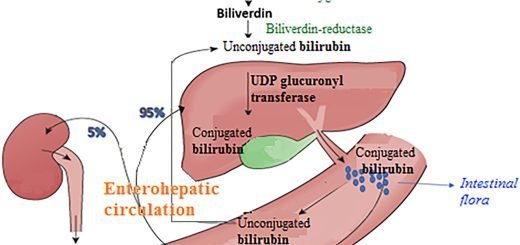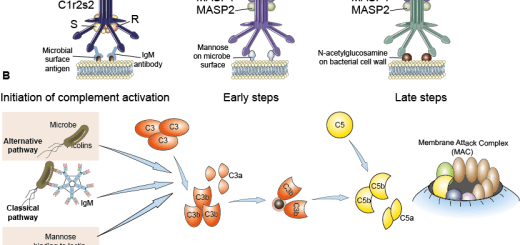Cerebrum function, structure, lobes, anatomy and location
The cerebrum, telencephalon, or endbrain is the largest part of the brain, It is composed of right and left hemispheres, It performs functions such as interpreting touch, vision, and hearing, as well as memory, speech, reasoning, emotions, learning, and fine control of movement, It is the uppermost part of the brain, It contains two hemispheres split by a central fissure.
Anatomy of the cerebrum
The cerebral hemisphere presents:
Three surfaces:
- Superolateral surface.
- Medial surface.
- Inferior surface.
Three borders:
- Supero-medial border.
- The infero-lateral border presents the pre-occipital notch which is about 5 cm in front of the occipital pole, The anterior part of this border is called the superciliary border.
- Medial border, which is divided into Medial orbital border and Medial occipital border.
Three poles:
- Frontal pole.
- Occipital pole.
- Temporal pole.
Each cerebral hemisphere is divided into 4 lobes:
- Frontal lobe.
- Parietal lobe.
- Temporal lobe.
- Occipital lobe.
Supero-lateral surface
Central sulcus
The upper end of this sulcus lies approximately midway between the frontal and occipital poles. It descends downwards and forwards on the supero-lateral surface where it ends slightly above the posterior ramus of the lateral sulcus. The central sulcus also extends on the medial surface of the cerebral hemisphere.
Lateral sulcus
This sulcus consists of a stem and 3 rami. The stem is present on the inferior surface of the cerebral hemisphere, This stem ends on the supero-lateral surface by dividing into 3 rami;
- Anterior ramus.
- Ascending ramus.
- Posterior ramus.
The main sulci and gyri of the frontal lobe are:
- Precentral sulcus: this sulcus runs parallel to and in front of the central sulcus.
- Precentral gyrus: this gyrus lies between the central and the precentral sulci, This gyrus corresponds to area 4 of Brodmann. Functionally, this gyrus is considered as the first or primary motor area, Here, the body is represented upside down.
- Superior and inferior frontal sulci: the superior frontal sulcus runs forwards from about the middle of the upper part of the precentral sulcus, The inferior frontal sulcus runs below and parallel to the previous one.
These two sulci divide this area of the frontal lobe into 3 gyri:
- Superior frontal gyrus: above the superior frontal sulcus.
- Middle frontal gyrus: between the superior and inferior frontal sulci, The posterior part of this gyrus presents area 8 which is the main part of the frontal eyefield.
- Inferior frontal gyrus: below the inferior frontal sulcus. This gyrus receives the anterior and ascending rami of the lateral sulcus.
The motor speech area (= Broca’s area): lies on both sides of the ascending concerned with the motor mechanisms of speech formulation.
The main sulci and gyri of the parietal lobe are:
- Postcentral sulcus: it runs parallel to and behind the central sulcus.
- Postcentral gyrus: this gyrus lies between the central and the postcentral sulci. It also extends on the medial surface of the cerebral hemisphere to form part of the paracentral lobule, Functionally it lodges the first or primary somatosensory area. Here also the body is represented upside down.
- The taste area is situated at the lower end of the postcentral gyrus in the superior wall of the lateral sulcus and in the adjoining area of the insula (Brodmann area 43).
- Intra-parietal sulcus: it runs from before backwards behind the postcentral gyrus dividing that area into superior (somatosensory association area) and inferior parietal lobule. The inferior parietal lobule receives the posterior parts of 3 sulci:
- The posterior end of the posterior ramus of the lateral sulcus which is surrounded supramarginal gyrus (area 40).
- The posterior end of the superior temporal sulcus which is surrounded by the angular gyrus (area 39)
- The posterior end of the inferior temporal sulcus.
The main sulci and gyri on the temporal lobe are:
- Superior temporal sulcus: it runs from before backwards parallel to and below the posterior ramus of the lateral sulcus.
- Inferior temporal sulcus: it is also parallel to and below the superior temporal sulcus.
- Superior temporal gyrus: the auditory area is present mostly in the floor of the lateral sulcus (in the anterior transverse temporal gyrus). It extends into the superior temporal gyrus below the lateral sulcus, and is here surrounded by the auditory association area.
- Middle temporal gyrus: it lies below and parallel to the superior temporal sulcus.
- Inferior temporal gyrus: it lies below and parallel to the middle temporal sulcus.
The main sulci and gyri on the occipital lobe are:
- Lunate sulcus: It is a curved sulcus that lies slightly in front of the occipital pole.
- Lateral occipital sulcus: it runs in front of the lunate sulcus dividing that part of the occipital lobe into superior and inferior occipital gyri.
The occipital lobe contains:
- Area 17: the primary visual area.
- Area 18 and 19: called secondary visual areas or visual association areas.
Medial surface
The main sulci and gyri on the medial surface of the cerebral hemisphere are:
- Cingulate sulcus: it is a curved sulcus that begins below the rostrum of the corpus callosum, then it passes in front of the genu, then above and parallel to the body of the corpus callosum. It ends by curving upwards towards the superomedial border behind the central sulcus to form the posterior boundary of the paracentral lobule.
- Callosal sulcus: just above the corpus callosum.
- Cingulate gyrus: it lies between the corpus callosum and the cingulate sulcus. The cingulate gyrus is responsible for learning, memory, and emotions i.e. limbic association cortex.
- Medial frontal gyrus: it is a part of the frontal lobe of the brain that lies in front of the ascending ramus of the Cingulate sulcus.
- The paracentral lobule: it is a part of the medial surface of the cerebral hemisphere that lies between the ascending ramus and the terminal part of the cingulate sulcus. This area receives the terminal part of the central sulcus, thus it contains part of the precentral and postcentral gyri. This area is responsible for motor and sensory functions of the leg, foot, and perineum.
- Calcarine sulcus: it begins anteriorly below the splenium of the corpus callosum and it extends posteriorly to the occipital pole where it curves slightly on the superolateral surface. It is joined by the parieto-occipital sulcus that divides it into precalcarine and postcalcarine sulci. The gyrus that lies below the calcarine sulcus is termed the lingual gyrus.
- Parieto-occipital sulcus: it is a vertical sulcus that cuts the superomedial border of the cerebral hemisphere about 5 cm in front of the occipital pole. It extends slightly on the superolateral surface. On the medial surface, it reaches the calcarine sulcus, where both sulci form a Y-shaped arrangement. The triangular area between the two limbs of this Υ-is termed Cuneus. The area in front of the cuneus is termed precuneus.
- Cuneus: it is a triangular area lying between the post calcarine and the parieto-occipital sulci. Its function is visual).
- Precuneus: this area lies between the terminal part of the cingulate sulcus and the parieto-occipital sulcus.
Inferior surface
The inferior surface of the cerebral hemisphere is divided by the stem of the lateral sulcus into an orbital part and a tentorial part.
A. The orbital part presents the following sulci and gyri:
- Olfactory sulcus: it is a straight sulcus that forms the lateral boundary of a longitudinal gyrus termed gyrus rectus.
- H-shaped orbital sulcus: it divides the lateral part of this area into anterior, posterior, medial and lateral orbital gyri.
B. The tentorial surface presents the following sulci and gyri:
- Rhinal sulcus: It is a small sulcus that lies in the anterior part of this surface near the temporal pole. It forms the lateral boundary of the uncus.
- Collateral sulcus: it extends posteriorly to end slightly near the occipital pole. Its anterior part forms the lateral boundary of the parahippocampal gyrus, Its posterior part is separated from the calcarine sulcus by the lingual gyrus.
- Uncus: it lies in the most anterior part of the tentorial surface where it is bounded laterally by the rhinal sulcus.
- Parahippocampal gyrus: it terminates at the level of the splenium of the corpus callosum. It is bounded laterally by the collateral sulcus.
- Lingual gyrus: it appears as a continuation of the parahippocampal gyrus where it is bounded laterally by the collateral sulcus and medially by the calcarine sulcus. It begins behind the level of the splenium of the corpus callosum. Functionally, this gyrus contains the visual areas.
- Occipito-temporal sulcus: it runs lateral and parallel to the collateral sulcus.
- Medial occipito-temporal gyrus: lies medial to the occipito-temporal sulcus.
- Lateral occipito-temporal gyrus: lies lateral to the occipito-temporal sulcus.
The anterior part of the parahippocampal gyrus and the uncus constitute the olfactory or piriform cortex.
You can subscribe to science online on Youtube from this link: Science Online
You can download Science Online application on Google Play from this link: Science Online Apps on Google Play
Referred pain examples, Causes of neuropathic pain & Pain control mechanisms
Physiology of pain sensation, Types of pain receptors, Effects of somatic pain & Visceral pain
Ascending tracts for somatic sensations & Deficits after lesions in the dorsal column pathway
Physiology of sensory receptors, Coding of sensory information & Somatic sensation
Skull function, anatomy, structure, views & Criteria of neonatal skull
Blood supply of CNS (central nervous system), Carotid system & Circle of Willis



